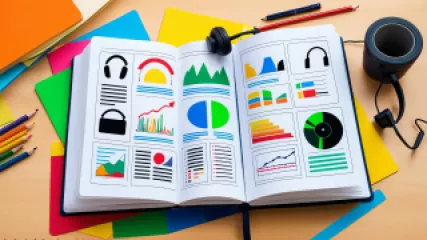Unlocking Learning Potential: A Step-by-Step Guide to Identifying Your Unique Learning Style
Unlocking Your Learning Potential: A Step-by-Step Guide
In the ever-evolving landscape of education and personal growth, understanding your unique learning style is the key to unlocking your full potential. Whether you're a student navigating the classroom, a professional seeking to enhance your skills, or an individual simply striving for self-improvement, recognizing how you learn best can be a game-changer. In this comprehensive guide, we'll embark on a journey to help you identify your predominant learning style and equip you with strategies to maximize your learning outcomes.
Exploring the Diverse Learning Styles
Learning is a multifaceted process, and individuals have a wide range of preferences and tendencies when it comes to absorbing, processing, and retaining information. The most widely recognized learning styles are:
Visual Learners
Visual learners are individuals who thrive on visual stimuli, such as images, diagrams, and written content. They often excel at understanding and recalling information that is presented in a visual format, and they tend to be highly observant and detail-oriented.
Auditory Learners
Auditory learners rely primarily on their sense of hearing to process information. They prefer to learn through lectures, discussions, and audio recordings, and they often find it helpful to verbalize their thoughts and ideas.
Kinesthetic Learners
Kinesthetic learners are hands-on individuals who learn best through physical interaction and experiential learning. They often excel in activities that involve movement, such as role-playing, simulations, and hands-on demonstrations.
Reading/Writing Learners
Reading/writing learners thrive on written materials, such as textbooks, articles, and reports. They prefer to learn through reading, writing, and engaging with textual information.
It's important to note that most individuals exhibit a combination of these learning styles, with one or two styles typically being more dominant. Understanding your predominant learning style can greatly enhance your ability to learn, retain, and apply new information effectively.
Identifying Your Learning Style
Determining your learning style can be a revealing and empowering experience. Here are some steps to help you identify your predominant learning style:
Observe Your Preferences
Reflect on your past experiences with learning and how you tend to approach new information. Do you find yourself drawn to visual aids, such as diagrams and charts? Do you prefer to listen to lectures or engage in discussions? Or do you find that you learn best when you can actively participate and experience the material?
Take a Learning Style Assessment
There are several online assessments and questionnaires available that can help you determine your learning style. These tools often present a series of questions or scenarios that allow you to identify your preferences and tendencies. Some popular assessment tools include the VARK Questionnaire, the Kolb Learning Style Inventory, and the VAK/VARK model assessment.
Experiment and Observe
Try different learning strategies and approaches, and pay attention to which ones resonate with you the most. For example, if you're a visual learner, try creating mind maps or infographics to help you understand and retain information. If you're an auditory learner, consider listening to audiobooks or podcasts to supplement your learning.
Seek Feedback
Engage with teachers, mentors, or peers who know you well and can provide valuable insights into your learning preferences. They may have observed patterns or tendencies that you haven't recognized yourself.
Strategies for Maximizing Your Learning Potential
Once you've identified your predominant learning style, the next step is to explore strategies and techniques that cater to your unique needs and preferences. By tailoring your learning approach, you can significantly enhance your ability to absorb, retain, and apply new information.
Strategies for Visual Learners
- Use visual aids, such as diagrams, charts, and infographics, to support your learning.
- Engage in activities that involve color-coding, highlighting, or creating visual representations of information.
- Utilize mind maps, flow charts, and other visual organizers to structure and connect ideas.
- Take notes using a combination of words and images to capture key concepts.
Strategies for Auditory Learners
- Participate in group discussions, debates, or presentations to actively engage with the material.
- Utilize recorded lectures, podcasts, or audiobooks to supplement your learning.
- Read content aloud or record yourself explaining the material to reinforce your understanding.
- Engage in verbal repetition or mnemonics to help memorize and recall information.
Strategies for Kinesthetic Learners
- Incorporate hands-on activities, simulations, or role-playing exercises into your learning process.
- Take frequent breaks to move around and engage in physical activity to enhance focus and retention.
- Use fidget toys or other physical objects to keep your hands occupied while learning.
- Experiment with different learning environments, such as standing or pacing, to find what works best for you.
Strategies for Reading/Writing Learners
- Prioritize reading and writing activities, such as taking detailed notes, summarizing key points, or composing essays or reports.
- Organize your learning materials, such as textbooks and articles, in a way that allows you to easily reference and review the information.
- Engage in writing exercises, such as journaling or creating outlines, to solidify your understanding of the material.
- Seek opportunities to present or share your knowledge through written communication, such as presentations or academic papers.
Embracing a Multifaceted Approach
While identifying your predominant learning style is crucial, it's important to recognize that learning is a multifaceted process. Oftentimes, the most effective approach involves incorporating a combination of strategies and techniques that cater to various learning styles.
For example, a visual learner may benefit from creating mind maps and diagrams, while also engaging in discussions (an auditory component) and hands-on activities (a kinesthetic component). By embracing a diverse range of learning strategies, you can maximize your chances of success and unlock your full potential.
Cultivating a Lifelong Learning Mindset
Identifying and leveraging your unique learning style is not a one-time exercise, but rather an ongoing process of self-discovery and growth. As you navigate different stages of your personal and professional life, your learning preferences may evolve, and it's essential to remain open and adaptable to new approaches.
Fostering a lifelong learning mindset is key to personal and professional development. By continuously exploring and experimenting with various learning strategies, you can enhance your ability to acquire new skills, expand your knowledge, and adapt to changing circumstances.
Seeking Support and Resources
Remember, you don't have to navigate the journey of self-discovery and learning alone. There are numerous resources and support systems available to help you along the way:
- Educational Institutions: Many schools, colleges, and universities offer learning style assessments, workshops, and coaching services to help students identify and develop their learning strategies.
- Coaching and Mentorship: Engaging with life coaches, educational specialists, or experienced mentors can provide invaluable guidance and personalized support in optimizing your learning potential.
- Online Resources: Explore a wealth of online articles, videos, and interactive tools that delve deeper into the various learning styles and offer practical tips and techniques.
- Mental Health Support: If you're experiencing challenges or barriers to your learning process, mental health resources and services can be instrumental in addressing any underlying issues or concerns.
Embracing the Power of Learning Style Awareness
Unlocking your learning potential is a transformative journey that can open doors to personal growth, academic success, and professional advancement. By understanding your unique learning style and embracing a diverse range of strategies, you can unlock your full potential and embark on a lifelong path of continuous learning and self-improvement.
Remember, your learning style is not a limitation, but rather a powerful tool to help you navigate the ever-evolving landscape of knowledge and skill development. Embrace this newfound understanding, and watch as it empowers you to achieve your goals and fulfill your aspirations. The journey of self-discovery awaits – are you ready to unlock your true learning potential?






